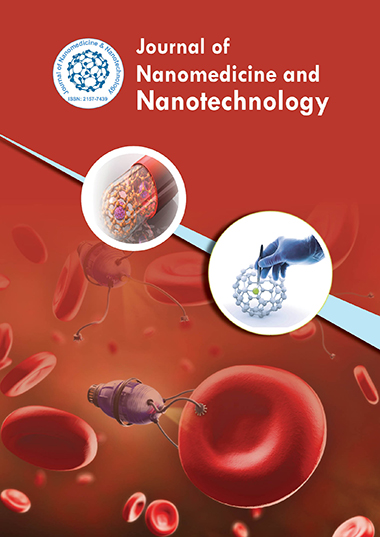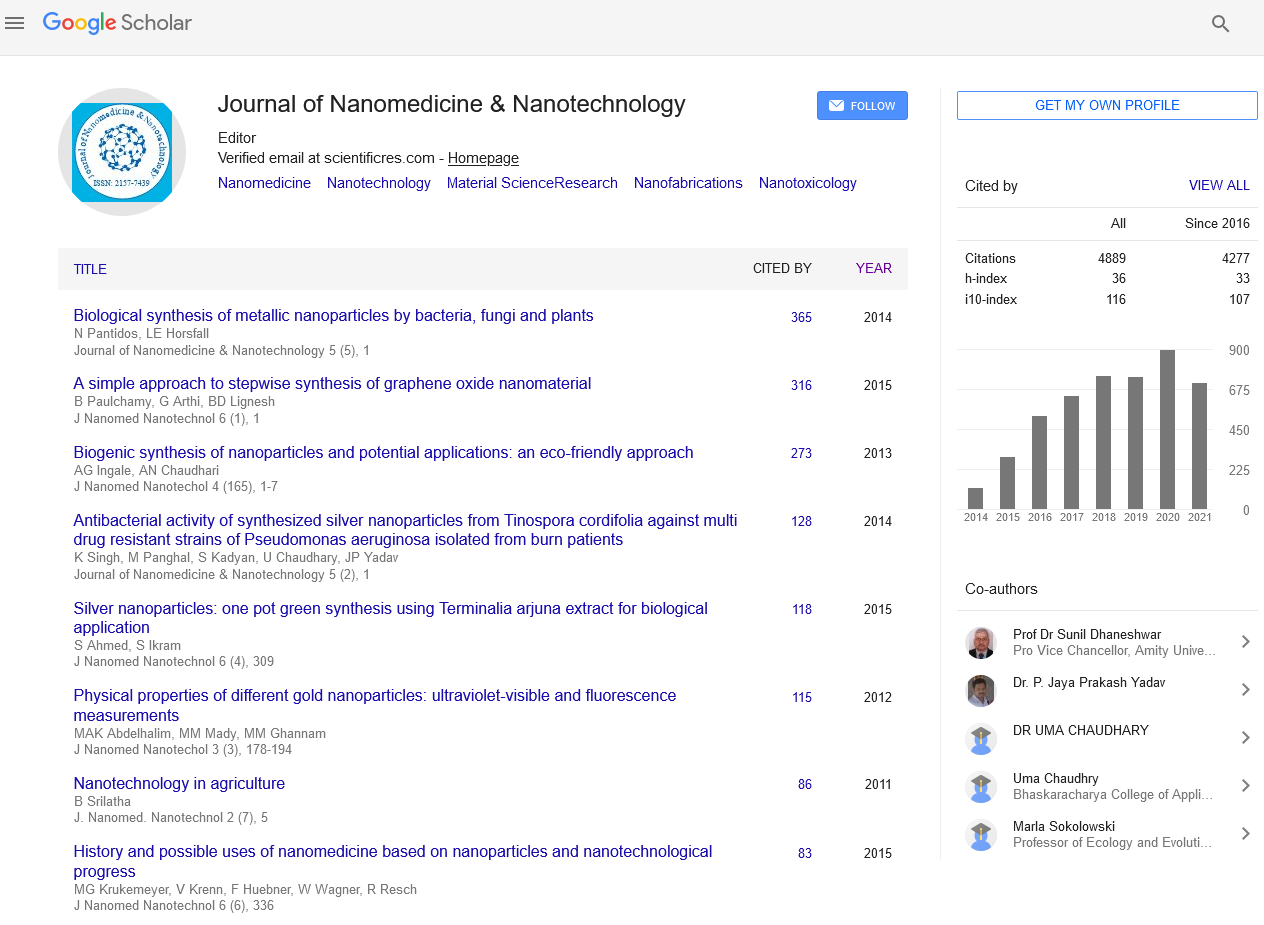Indexed In
- Open J Gate
- Genamics JournalSeek
- Academic Keys
- JournalTOCs
- ResearchBible
- China National Knowledge Infrastructure (CNKI)
- Scimago
- Ulrich's Periodicals Directory
- Electronic Journals Library
- RefSeek
- Hamdard University
- EBSCO A-Z
- OCLC- WorldCat
- SWB online catalog
- Virtual Library of Biology (vifabio)
- Publons
- MIAR
- Scientific Indexing Services (SIS)
- Euro Pub
- Google Scholar
Useful Links
Share This Page
Journal Flyer

Open Access Journals
- Agri and Aquaculture
- Biochemistry
- Bioinformatics & Systems Biology
- Business & Management
- Chemistry
- Clinical Sciences
- Engineering
- Food & Nutrition
- General Science
- Genetics & Molecular Biology
- Immunology & Microbiology
- Medical Sciences
- Neuroscience & Psychology
- Nursing & Health Care
- Pharmaceutical Sciences
Editorial - (2025) Volume 16, Issue 1
Nanoparticle-Mediated Restoration of p53 Tumor Suppressor Activity in Cancer Cells
Elowen Sterling*Received: 01-Jan-2025, Manuscript No. jnmnt-25-28319; Editor assigned: 03-Jan-2025, Pre QC No. jnmnt-25-28319 (PQ); Reviewed: 16-Jan-2025, QC No. jnmnt-25-28319; Revised: 23-Jan-2025, Manuscript No. jnmnt-25-28319 (R); Published: 31-Jan-2025, DOI: 10.35248/2157-7439.24.16.772
INTRODUCTION
The p53 tumor suppressor protein, often referred to as the "guardian of the genome," plays a pivotal role in maintaining cellular integrity by regulating key processes such as cell cycle progression, DNA repair, apoptosis, and senescence. It functions as a transcription factor that responds to various cellular stresses, including DNA damage, oncogene activation, and hypoxia. When activated, p53 induces cell cycle arrest or apoptosis in response to cellular damage, preventing the propagation of potentially oncogenic mutations. However, mutations in the TP53 gene, which encodes the p53 protein, are among the most common genetic alterations in human cancers, leading to the loss of p53's tumor-suppressive functions and contributing to tumorigenesis, metastasis, and resistance to conventional therapies. Given the central role of p53 in tumor suppression, strategies aimed at restoring its function in cancer cells have garnered significant attention as a potential therapeutic approach. Traditional methods, such as gene therapy and small molecules, have faced challenges in efficiently delivering agents to tumor cells while minimizing off-target effects. In recent years, nanoparticle-based delivery systems have emerged as a promising strategy for the restoration of p53 tumor suppressor activity. Nanoparticles offer distinct advantages, including the ability to encapsulate a variety of therapeutic agents, enhance cellular uptake, and provide targeted delivery to tumor sites. This article explores the potential of nanoparticle-mediated restoration of p53 activity in cancer cells, focusing on mechanisms, advantages, challenges, and future directions in cancer therapy [1].
MECHANISMS OF P53 TUMOR SUPPRESSOR ACTIVITY RESTORATION
The loss of p53 function in cancer cells is primarily due to mutations or deletions in the TP53 gene, which result in either a non-functional or completely absent p53 protein. In some cases, p53 may be inactivated by overexpression of its negative regulators, such as MDM2, a protein that binds to p53 and promotes its degradation. Additionally, certain post-translational modifications, including phosphorylation and acetylation, can modulate p53 activity, making it less effective in inducing cell cycle arrest or apoptosis. Restoring p53 function in these cells offers a promising strategy to halt tumor progression and enhance the efficacy of existing therapies [2]. Nanoparticle-based systems can restore p53 activity in cancer cells through several mechanisms. One approach involves delivering functional p53 protein or its encoding gene to the tumor site. Nanoparticles can encapsulate the p53 gene or recombinant p53 protein, protecting it from degradation during circulation and ensuring its release directly into the tumor cells. Once inside the cell, the delivered p53 protein can engage with its target genes and restore its tumor-suppressive functions, such as inducing cell cycle arrest and apoptosis in response to DNA damage [3]. Another strategy involves targeting the upstream regulators of p53. For instance, nanoparticles can be used to deliver small molecules or RNA-based therapies, such as small interfering RNA (siRNA) or antisense oligonucleotides, that inhibit MDM2 or other negative regulators of p53. Inhibition of MDM2 would prevent the degradation of p53, allowing it to accumulate and restore its tumor-suppressive functions in cancer cells. Similarly, nanoparticles can be designed to deliver compounds that enhance p53â??s activity by promoting its post-translational modifications, such as acetylation or phosphorylation, which may enhance its stability and transcriptional activity [4].
ADVANTAGES OF NANOPARTICLE-MEDIATED P53 RESTORATION
Nanoparticle-based delivery systems offer several advantages over traditional methods for restoring p53 activity in cancer cells. One of the primary benefits is the ability to encapsulate and protect therapeutic agents, such as p53 genes, proteins, or small molecules, from degradation by nucleases or the immune system. Nanoparticles, especially those made from biocompatible and biodegradable materials, provide a stable environment for these agents, ensuring their safe and efficient delivery to the tumor site. The size and surface characteristics of nanoparticles can be tailored to enhance their ability to penetrate tumor tissues. Tumors typically exhibit abnormal vasculature, with leaky blood vessels that allow nanoparticles to accumulate in the tumor via the enhanced permeability and retention (EPR) effect. This phenomenon allows for the selective delivery of nanoparticles to the tumor, reducing systemic side effects and enhancing the therapeutic index of the treatment. Additionally, nanoparticles can be functionalized with targeting ligands, such as antibodies, peptides, or small molecules, that specifically bind to receptors overexpressed on cancer cells. This targeting capability further enhances the specificity of nanoparticle-mediated delivery, ensuring that p53 restoration occurs predominantly in tumor cells [5]. Another key advantage is the controlled release of therapeutic agents. Nanoparticles can be designed to release their payloads in response to specific stimuli, such as acidic pH, enzymatic activity, or redox conditions present in the tumor microenvironment. This allows for a more controlled and sustained release of p53 or its activators, increasing the likelihood of therapeutic success while minimizing off-target effects. Moreover, nanoparticles can be used to co-deliver multiple therapeutic agents, such as chemotherapeutic drugs, immune modulators, or other gene therapies, in combination with p53 restoration. This multi-modal approach can enhance the overall effectiveness of cancer treatment by targeting various aspects of tumor biology, such as DNA damage repair, apoptosis, and immune evasion [6].
CHALLENGES AND LIMITATIONS
Despite the promising potential of nanoparticle-mediated restoration of p53 activity, several challenges remain in its development and clinical translation. One of the major concerns is the potential toxicity of nanoparticles, particularly with repeated administration. The accumulation of nanoparticles in non-target organs, such as the liver and spleen, could lead to unwanted side effects. Therefore, the design of nanoparticles with improved biocompatibility and biodegradability is essential to minimize toxicity and improve the safety profile of the treatment [7]. Additionally, the successful delivery of therapeutic agents to tumor cells remains a significant challenge. Although the EPR effect allows for passive tumor targeting, the heterogeneity of tumors can lead to variability in the accumulation and distribution of nanoparticles. Tumor microenvironments are also often characterized by low pH, high interstitial pressure, and hypoxia, which can limit nanoparticle penetration and affect the efficacy of the treatment. Strategies to enhance nanoparticle penetration, such as using surface modifications or combining nanoparticles with other therapies, may be necessary to overcome these barriers [8]. Another challenge is the complexity of restoring p53 function in cancer cells. Many tumors harbor multiple mutations or alterations in signaling pathways that could interfere with the reactivation of p53. For example, mutations in other tumor suppressor genes or alterations in apoptotic pathways could hinder the ability of p53 to effectively induce cell death. Furthermore, the development of resistance to treatment could be another concern, as tumors may evolve to evade the restored activity of p53.
FUTURE DIRECTIONS
The development of nanoparticle-based strategies to restore p53 tumor suppressor activity holds great promise for improving cancer therapy. Ongoing advancements in nanoparticle design, such as the use of multifunctional nanoparticles, can help address some of the challenges related to targeting efficiency, controlled release, and tumor penetration. Additionally, combining nanoparticle-mediated p53 restoration with other treatment modalities, such as chemotherapy, immunotherapy, or radiation, could enhance the overall therapeutic response and overcome resistance mechanisms [9]. Future research efforts should focus on optimizing the design and formulation of nanoparticles to improve their biocompatibility, reduce toxicity, and ensure effective delivery of therapeutic agents. Moreover, personalized treatment approaches, including the identification of specific mutations in p53 and related pathways, will be essential in developing tailored therapies for individual patients [10].
CONCLUSION
In conclusion, nanoparticle-mediated restoration of p53 tumor suppressor activity represents a promising and innovative strategy for the treatment of cancers characterized by p53 loss or dysfunction. By leveraging the unique properties of nanoparticles for targeted delivery, controlled release, and multi-modal therapy, this approach has the potential to provide a more effective and less toxic alternative to conventional cancer treatments. With continued research and development, nanoparticle-based therapies could become a cornerstone of personalized cancer treatment, improving patient outcomes and quality of life.
REFERENCES
- Dong Y, Love K T, Dorkin J R, Sirirungruang S, Zhang Y, Chen D, Â et al. Lipopeptide nanoparticles for potent and selective siRNA delivery in rodents and nonhuman primates. Proc Natl Acad Sci. 2018; 111(11): 3955-3960.
- Li Y, Wang Y, Huang G, Gao J, Cooper I R, Ji J, et al. Recent progress in smart drug delivery nanosystems using stimuli-responsive polymers. J Mater Chem B. 2019; 7(8): 1139-1161.
- Miao L, Huang L, Exploring N. Nano-enabled delivery of RNAi and CRISPR-Cas9 for cancer treatment. Nano Today. 2020; 32: 100853.
- Wang Z, Li X, Ying Z. Combining Magnetic Nanoparticles and Ultrasound for Drug Delivery in Cancer: A Comprehensive Review. Crit Rev Oncol Hematol. 2018; 131: 34-49.
- Lentacker I, Geers B, Demeester J. De Smedt, S. C. Advanced Delivery Strategies for Anticancer Nanomedicine. Nanomedicine. 2021; 7(2): 179-196.
- Qin B, Pei J, Guo H, Dong X, Zong B, Li D. Bioinspired nanoparticles for direct intratumoral chemotherapy of local cancer. J Mater Chem B. 2019; 7(23): 3646-3652.
- Shi Y, van Steenbergen M J, Teunissen A J P, van der Meel R, Lammers T. Drug delivery strategies for platinum-based anticancer drugs. Expert Opin Drug Deliv. 2020; 17(5): 587-604.
- Ma D, Zhang, H B, Shu W. Integration of a Nanocarrier-Based Platform for Dual-Responsive Cocktail Chemotherapy and Dual-Modal Imaging. Advanced Materials. 2019; 31(12): 1807887.
- Hobbs S K, Monsky, W L, Yuan F, Roberts W G, Griffith L, et al. Regulation of transport pathways in tumor vessels: Role of tumor type and microenvironment. Proc Natl Acad Sci. 2018; 95(8): 4607-4612.
- Kieran D, Woods A, Villalta-Cerdas A, Weiner S. Tumor-associated antigens for the induction of antitumor immune responses. Annual Review of Immunology. 2020; 39: 251-272.
Indexed at, Google Scholar, Crossref
Indexed at, Google Scholar, Crossref
Indexed at, Google Scholar, Crossref
Indexed at, Google Scholar, Crossref
Indexed at, Google Scholar, Crossref
Indexed at, Google Scholar, Crossref
Indexed at, Google Scholar, Crossref
Indexed at, Â Google Scholar, Crossref
Citation: Elowen S (2025) Nanoparticle-Mediated Restoration of p53 Tumor Suppressor Activity in Cancer Cells. J Nanomed Nanotech. 16: 772.
Copyright: ©2025 Elowen S. This is an open-access article distributed under the terms of the Creative Commons Attribution License, which permits unrestricted use, distribution, and reproduction in any medium, provided the original author and source are credited.


